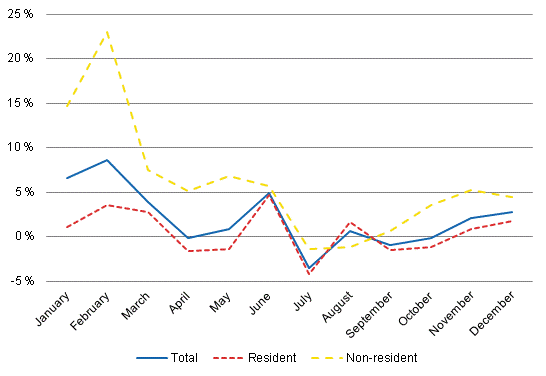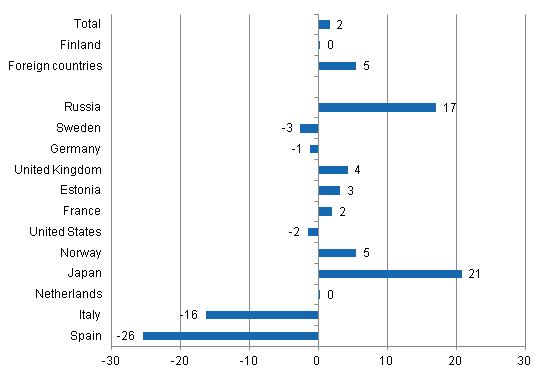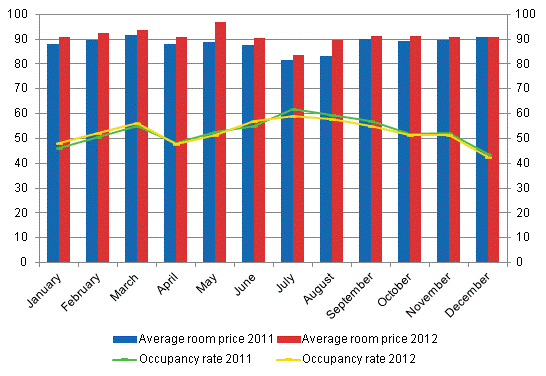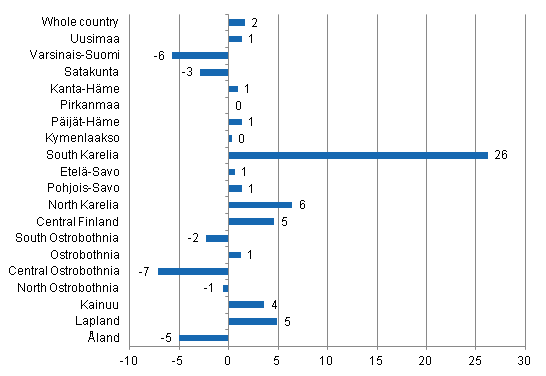Published: 31 May 2013
Foreign demand for accommodation services grew by five per cent in 2012
In 2012, the demand for accommodation services grew by two per cent from the previous year. A record level of 20 million was exceeded in the number of overnight stays. As in the year before, the engine behind the growth was increased foreign demand. Overnight stays by foreign tourists increased by five per cent while the number of nights spent by domestic tourists remained at last year's level. In 2012, accommodation establishments in Finland recorded a total of 20.3 million overnight stays, of which domestic tourists accounted for 14.5 million and foreign tourists for the remaining 5.8 million. These figures are data from Statistics Finland’s statistics on accommodation establishments and they have been collected from accommodation establishments with at least 20 beds or caravan pitches with electricity connection, and youth hostels.
Year-on-year changes in nights spent (%) by month 2012–2011

Russians formed the largest group of foreign visitors in 2012
Russians have been the largest group of foreign visitors to Finland since 2006, and 1.5 million overnight stays were recorded for Russian tourists in 2012, which was 17 per cent more than in 2011. The share of Russians in all overnight stays by foreign tourists was 26 per cent. Swedish and German visitors came next. The overnight stays of both groups represented some one-third of the overnight stays by Russians, or good 0.5 million overnight stays. Overnight stays by Swedish visitors decreased by 2.7 per cent, and those by visitors from Germany by 1.3 per cent from 2011. By contrast, overnight stays by British tourists made an upturn after a three-year recession and increased by four per cent in 2012. Overnight stays recorded for them at accommodation establishments numbered nearly 406,000. Overnight stays by Estonian and French tourists rose to good 200,000 nights each and the increase from 2011 amounted to two to three per cent. Among the most important countries of inbound tourism into Finland, overnight stays of visitors from Spain and Italy decreased most. Overnight stays by both groups fell throughout 2012. Accommodation establishments recorded 26 per cent fewer overnight stays for Spanish tourists and 16 per cent fewer for Italian tourists than in 2011.
Accommodation establishments recorded a slight loss in the number of nights spent by tourists from EU countries in 2012, which was partly explained by the steep decrease in overnight stays of visitors from Spain and Italy. Overall, nearly 2.9 million overnight stays were recorded for visitors from EU countries, which was 1.7 per cent fewer than in 2011. By contrast, considerable growth was seen in the overnight stays by Asians that increased by nearly ten per cent. Overnight stays recorded for Japanese visitors increased by as much as 20.8 per cent and those for Chinese visitors by 8.6 per cent from the previous year. Overnight stays by visitors from South Korea grew by 6.7 per cent and those by visitors from Taiwan by good one per cent, while overnight stays by Indian tourists decreased by one-fifth from 2011.
Change in overnight stays 2012 / 2011, %

Overnight stays at hotels numbered 16.3 million
In 2012, the total number of nights spent in hotels totalled 16.3 million, which was 2.1 per cent higher than in 2011. Recorded nights spent by resident tourists in hotels numbered 11.4 million. The number was 0.8 per cent higher than in the year before. Overnight stays by foreign tourists increased by 5.4 per cent and hotels recorded nearly 4.9 million of them.
The occupancy rate of hotel rooms for the whole country was 52.6 per cent in 2012. One year earlier, it was nearly the same at 52.9 per cent. The average price of a hotel room made an upturn in 2011, when the price was EUR 88. In 2012, the average price of a hotel room rose close to EUR 91.
Hotel room occupancy rate and the monthly average price

Regional development of overnight stays in 2012
In 2012, the largest growth percentage by far for overnight stays was recorded in the region of South Karelia where the capacity of accommodation establishments also increased heavily. Overnight stays in South Karelia grew by 26.3 per cent, while the second highest growth was seen in North Karelia, 6.4 per cent. Central Finland and Lapland both had a growth of nearly five per cent. By contrast, overnight stays in Central Ostrobothnia decreased by 7.2 percent, in Varsinais-Suomi by 5.7 per cent and in Åland by 5.0 per cent. In absolute numbers, overnight stays in accommodation establishments increased most in South Karelia and Lapland, where good 100,000 more stays than in 2011 were recorded for both.
The share of overnight stays by foreign tourists of all overnight stays was 47 per cent in South Karelia, 45 per cent in Uusimaa and 41 per cent in Lapland. These regions also recorded most overnight stays by Russians. In Uusimaa, good 420,000 overnight stays were recorded for Russians, in South Karelia 250,000 and in Lapland almost 120,000.
In Kymenlaakso, the share of overnight stays by foreign tourists of all overnight stays was 29 per cent and in Etelä-Savo close to 24 per cent. In other regions of Finnish mainland, at most one night in five was spent by a foreign visitor.
Change in overnight stays by region 2012/2011,%

The capacity of accommodation establishments increased in 2012
Population of the accommodation statistics was extended in 2012 as a result of the regulation no 692/2011 of the European Parliament and the Council concerning European statistics on tourism, according to which data are collected from accommodation establishments with at least 20 beds or caravan pitches with electricity connection. The population of the accommodation statistics was extended to smaller accommodation establishments than before. The number of accommodation establishments contained in the statistics grew by good one hundred in 2012, by some 3,000 rooms and over 8,000 beds. In absolute numbers, the biggest changes were directed at holiday villages, hotels and youth hostels. Because of the revision, the capacity data are not fully comparable with those for earlier years.
In 2012, the statistics covered a total of 1,427 accommodation establishments; 682 hotels, 157 guest houses, 286 holiday villages, 246 camping sites and 56 youth hostels. Holiday villages of hotel calibre are included in hotels. The accommodation establishments had 66,418 rooms (or cottages) with a total of 161,632 beds. In addition to room and bed capacity, the accommodation establishments had 21,261 caravan pitches with electricity connection of which 16,652 were located at camp sites.
When the capacity of accommodation establishments is viewed according to the number of rooms, the statistics contained 1,057 establishments with less than 50 rooms and 370 establishments with at least 50 rooms in 2012. Measured by bed capacity, there were 976 establishments with less than one hundred beds and 451 establishments with at least one hundred beds.
In 2012, there were 1,073 accommodation establishments that were open year round and 354 establishments that were open part of the year; these were mostly camp sites and holiday villages.
Source: Accommodation Statistics. Statistics Finland
Inquiries: Marjut Tuominen 09 1734 3556, Ossi Nurmi 09 1734 2984, liikenne.matkailu@stat.fi
Director in charge: Hannele Orjala
Publication in pdf-format (472.7 kB)
- Tables
-
Tables in databases
Pick the data you need into tables, view the data as graphs, or download the data for your use.
Appendix tables
- Appendix table 1. Capacity and its utilization in 2012 (31.5.2013)
- Appendix table 2. Nights spend in all establishments in 2012 (31.5.2013)
- Appendix table 3. Hotel capacity and capacity utilization in 2012 (31.5.2013)
- Appendix table 4. Nights spend in hotels in 2012 (31.5.2013)
- Appendix table 5. Visitor arrivals and nights spend by country of residence in 2012 (31.5.2013)
- Appendix table 6. Nights spend in all establishments by month in 2012 (31.5.2013)
- Appendix table 7.1. Nights spent by non-residents and annual change (%) in all establishments in 2012 (31.5.2013)
- Appendix table 7.2. Nights spent by non-residents and annual change (%) in all establishments in 2012 (31.5.2013)
- Appendix table 8.1. Nights spent by non-residents and annual change (%) in hotels in 2012 (31.5.2013)
- Appendix table 8.2. Nights spent by non-residents and annual change (%) in hotels in 2012 (31.5.2013)
- Appendix table 9.1. Capacity of accommodation establishments and capacity utilization by type of establishment in 2012 (31.5.2013)
- Appendix table 9.2. Capacity of accommodation establishments and capacity utilization by type of establishment, May-August 2012 (31.5.2013)
- Appendix table 10.1. Capacity of accommodation establishments by type of establishment in 2012 (31.5.2013)
- Appendix table 10.2. Capacity of accommodation establishments by opening season in 2012 (31.5.2013)
- Appendix table 10.3. Capacity of accommodation establishments by number of bed-places in 2012 (31.5.2013)
- Appendix table 10.4. Capacity of accommodation establishments by number of rooms in 2012 (31.5.2013)
Updated 31.5.2013
Official Statistics of Finland (OSF):
Accommodation statistics [e-publication].
ISSN=1799-6325. 2012. Helsinki: Statistics Finland [referred: 14.11.2025].
Access method: http://stat.fi/til/matk/2012/matk_2012_2013-05-31_tie_001_en.html

